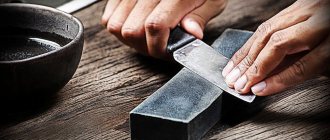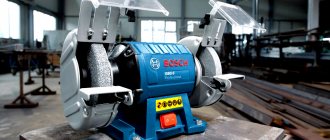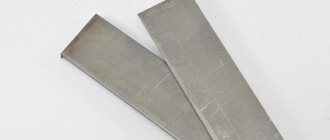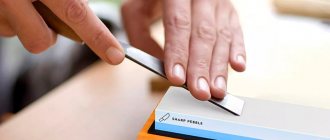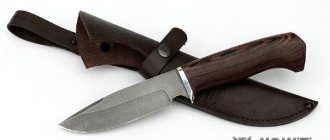Without proper care and compliance with operating rules, any knife will quickly become unusable. This kitchen helper must have a sharp blade to cut well. Find out what ways to restore original cutting properties or improve existing ones in the review of budget and specialized sharpening methods.
Knife sharpener: an assistant in sharpening knives.
How to use a knife with wheels
The operating principle of this sharpener is based on the rotation of two rollers. They act like millstones, between which the blade is inserted and sharpened on both sides. The rollers are coated with an abrasive substance - diamond or ceramic coating. When the wheels turn, the blade is ground at a 45° angle. The movements are repeated 4-5 times.
For frequent cutting of meat, fish and hard foods, sharpening is not the best option, since a wheeled sharpener will have to be used before each preparation.
How to use the knife:
- Knife with a wheel.
The blade is inserted into the slot first with a slant to the left and processed, then the right side. - When approaching the tip, you need to slightly lift it by the handle.
There is no need to treat the blade with water before the procedure, but after it is necessary to wash off metal particles.
How else to sharpen knives
Dull knives spoil food, so to avoid spoilage of the dish, they must be sharpened. If you perform this ritual incorrectly, the result will be even worse. Therefore, you should not take risks without being sure of the success of the business, otherwise the instrument will be damaged.
For example, only diamond-coated stones are suitable for ceramic tools. But Damascus steel and bread knives require only professional processing.
On the grinding machine
Sharpening on a machine.
It is one of the most effective turning methods. The round whetstone rotates at high speed. At this moment, a knife is applied at the desired angle and the blade is drawn along the surface of the stone.
In this case, the pressure exerted by your fingers should be the same throughout the entire process.
With the machine, the quality and speed of sharpening are high. The device is durable, but few people want to spend money on buying a unit. In addition, the speed of rotation is so high that only professionals can sharpen safely with it - the method is very dangerous. Without experience, adjusting the sharpening angle is problematic.
Stone
When hiking, outdoors and in other extreme conditions, you can take an ordinary stone or cobblestone. Run the cutting part along the stone, like on a sharpening machine. The effect will not be achieved so quickly, at least 10 movements. This is only a temporary measure. Returning home, you will need to put the instrument in order using special tools. It is a sharpening stone, which will last a long time, but is not cheap.
In nature, preference should be given to smooth and sea stones. Rough, rough stones will further damage the cutting edge.
On sandpaper
Sandpaper has long been used to scribble various surfaces, including cutting surfaces. Almost every housewife uses this method when sharpening kitchen knives. To do this, 2 pieces of soft and hard sandpaper are glued to the blocks of wood on both sides with adhesive tape/insulating tape. You need to process the surface until it becomes rough on both sides. It is necessary to achieve their disappearance, then we can talk about sharpness.
Knife on knife
The simplest Soviet method is to take 2 knives and rub them against each other. The duration of rubbing is about 10 minutes. The quality of sharpening leaves much to be desired, but instant results are achieved in a short time. In addition, friction causes the metal to crumble. If you do not wash the product, particles will end up on food.
File
Sharpening methods.
Compared to sandpaper, this is a rough sharpening method. Even the softest files are not able to provide a delicate finish to the blade. You need to choose a file on which the size of the notches will be medium, so as not to scratch the blade.
Electric sharpener
Similar to mechanical sharpening, but with an electric drive. Multifunctional tool used for sharpening knives, scissors, etc. The sharpener is efficient and fully automatic. The performance of the device depends on the power of the electric motor.
Damascus steel and professional knives will be damaged by an electric sharpener.
Selection of sharpener
At home, you can easily sharpen kitchen blades to the required sharpness quite quickly. To do this, you just need to choose the right sharpening stones.
Options for sharpening stones:
- natural;
- diamond;
- ceramic;
- water Japanese.
To begin with, it is better to purchase several inexpensive whetstones and practice sharpening knives with them for some time. And when you have enough experience, you can purchase a set of expensive Japanese or diamond stones.
Recommendations for purchasing sharpeners:
- The ideal length of the bar is 1.5-2 times the length of the knife blade, but not shorter. The shape and width of the sharpener does not matter.
- There should be no chips on the block. Its surface must be perfectly flat.
- To gain experience in sharpening knives, it is recommended to buy a universal stone of medium hardness or a block, the sides of which have different grain sizes (you can have two separate stones with fine and large grain sizes). Over time, the collection of sharpening products can be replenished.
- It would be nice to get some donkeys that were produced back in the Soviet Union. Such products can be found at flea markets and must be marked “Made in the USSR”. Soviet-made bars are distinguished by high-quality binding material and uniform grains.
- To sharpen a knife to the sharpness of a razor blade, you will need not only sharpening stones, but also a special GOI abrasive paste.
If you have no practice in sharpening knives, it is recommended to purchase an ordinary ceramic stone made in the shape of a boat. It can be purchased at any hardware store. This is an inexpensive product characterized by increased wear resistance and a long service life. The only negative is that such bars wear out unevenly.
Kitchen knife sharpening angle
Knife sharpening angle.
Kitchen knives come in different types, so each one needs to be sharpened differently. Thus, filleting and boning tools are processed at an angle of 25°, cutting tools - 25-30°, shredding tools - 35°.
For hunting knife
A sharpening angle of 30-35° is suitable for hunting knives. You need to restore your cutting ability with the help of professional tools, since the blade is wide and thick.
Hunting and camping knives
The main difference between hunting and camping knives and kitchen knives is the metal used. It is much stronger, withstands bending better, and is also thicker. In addition, the handle of the knives is more comfortable and allows you to more securely fix the knife in your hand.
In addition, the method of sharpening such knives is also different. It is quite possible to sharpen a knife with a stone, but with hard metal it is a rather long task that can take 2-3 hours before an average result is achieved.
When sharpening hunting knives, one whetstone will not be enough; it is advisable to have a leather belt or a wide leather strip designed specifically for grinding the edges of knives.
It can be purchased at a specialty store, the cost is quite high. Its task is to grind the edges of knives after several stages of sharpening; it is thanks to it that it is possible to achieve the highest possible sharpness on a specific type of metal.
It is recommended to watch a video with a detailed analysis and overview of the nuances of turning hunting knives, as well as familiarize yourself with safety precautions when carrying out such work, especially when using machines.
Sharpening knives on a knife blade
Specialized knife care devices include knife blades. With their help, sharpening occurs quickly, but with frequent use the blade becomes dull. They can be mechanical or electric on rollers.
At what angle
It depends on the functional purpose of the blade. The sharpening angle of the razors is 12°. Fillet knives become sharp at 15°. For kitchens, 20° is suitable. But even so, each leading tool has areas that require different sharpening.
Manual sharpening procedure
It would seem that sharpening a knife yourself is a simple matter. However, without knowing certain rules, the work will go down the drain:
- Place a sanding block on the table. It is advisable to secure it.
- Choose a sharpening angle and do not stray from it in the process.
- Movements should be smooth and uniform, without strong pressure, “from yourself.”
- The knife must go completely; Having reached the tip, continue movements in the opposite direction.
- Sharpen until burrs appear on both sides of the blade.
- Change the block with increasingly finer abrasive until the cutting part becomes mirror-like.
What to pay attention to
When purchasing kitchen knives, you need to pay attention to the type of metal that was used to create the blades. The optimal sharpening method depends on this type. Many people are accustomed to sharpening knives with a whetstone; this is actually a universal option, but the whetstone should also be selected carefully.
There are more varieties of sharpening stones. They are all divided into 3 types:
- For rough sharpening. Allows you to straighten the blade after notches and give the edge the correct shape.
- For medium sharpening. Grinds the blade and edge so that it can be sharpened efficiently.
- For soft sharpening. It is used at the final stage, when the blade needs to be given maximum sharpness.
The best option is diamond bars, they have an excellent price/quality ratio, and they also have a long service life.
How to test the sharpness
Checking the sharpness of the blade is carried out in several proven ways:
- paper - hold the sheet with one hand and strip the paper with the other. With sufficient sharpness, cutting will go like clockwork;
- tomato - place the vegetable on the table and cut horizontally;
- on hairs - carefully press the blade to the skin of your hand and lightly run through the hair on it. If the “epilation” is successful, then the blade is sharp.
Checking knives on tomatoes.
Sharpening theory: profile and type
The blade profile (geometry) refers to the contour formed by sharpening. The profile outlines the part of the blade that will be in contact with the material while using the knife. Different tools have different blades and their own characteristic profile.
Its shape is related to the properties of the material used and the purpose of the tool. Using blade processing, the following types of profiles are formed:
- A simple blunt wedge. The blade is durable, but rough. It creates significant cutting resistance, and cutting rather viscous materials leaves a ragged mark.
- Sharp wedge. It is poorly suited for cutting, quickly becomes dull, and may chip. When cutting tough or fibrous materials, the result may be worse than with a dull blade due to high friction and cutting resistance.
- Ogival (bullet-shaped). The slopes (the sides of the cut line) have a characteristic convex shape. Such a blade is expensive and difficult to make even in production conditions. Tools with a bullet-shaped sharpening are made for special equipment (for example, medical equipment, when studying the thinnest tissue sections).
Model of a desktop sharpener with the ability to change the sharpening angle Source ytimg.com
- Faceted. Faceted geometry is used for disposable safety razor blades. The cutting part ends with edges (straight segments). Hex sharpening is considered universal. A profile with 3-4 edges is suitable for coarse hair, with eight – for the finest hair.
The most common is traditional double-sided sharpening; its variety is lens sharpening. It has high cutting efficiency and is considered the best choice of blade options. However, it is quite difficult to implement, which increases the cost of finished products, regardless of whether it is a kitchen tool, hunting, folding or tourist. There are knives with other, more specific blade shapes that determine the functionality and ease of use of the tool.
Bottom line
You don't have to be a chef to have a good cutting knife in your kitchen. Over time, the blade wears out, which greatly complicates the cooking process and turns it from pleasure into torture. Thanks to sharpening, the properties of the blade are restored.
Previous
Ancient HOK Pugio dagger - weapon of Roman legionnaires
Next
Making knivesKunai: cut and size of knife for throwing
Electric sharpening machines
Electric sharpeners are bulkier than other knife sharpening devices. They are connected to a 220 volt network. They have many modes for sharpening. As a rule, the sharpening elements in the machine are enough for 2000-3000 sharpenings (and some models have replaceable sharpening elements), due to which they are often used in restaurants and specialized workshops.
Their sharpening process is the fastest. You need to insert the knife into the desired groove and move it several times.
A big advantage of electric sharpeners that have diamond abrasive discs installed (for example: Nakatomi NEC-2000) is the ability to sharpen not only steel knives, but also ceramic ones.
Rules for using a whetstone
To ensure the desired cutting qualities of the knife, the following recommendations should be taken into account:
- Soak the stone in water for 15 - 20 minutes;
- to work you need a table in a well-lit place or with a lamp;
- to prevent the stone from slipping and damaging the table covering, place a cloth or paper on the table;
- to visually determine the sharpening angle of the knife, the blade is applied to the sharpening stone;
- the blade being sharpened is directed away from you at the selected angle;
- with gentle pressure, a reciprocating movement is produced, simulating cutting off a thin film from a grindstone along its entire plane. In this case, the blade moves relative to the block from the handle to the tip and back;
- the selected sharpening angle is maintained during each stroke of the stone;
- the blade and stone are periodically moistened with water and cleaned;
- after 20 - 30 repetitions on both sides of the blade, the cutting edge is inspected. When sharpened with a razor, it is not visible to the naked eye;
- The sharpness of the blade is checked on a sheet of paper by cutting it from top to bottom. A sufficiently sharp blade cuts and does not tear paper.
Folk remedies for washing dishes - benefits, savings or a waste of time
Sharpening devices, practical at home
The list of sharpening devices used in everyday life includes hand-held devices. A popular option is musat. Professional chefs use it to quickly sharpen (sharpen) a knife that has become slightly dull. Musat looks like a long rod with a round cross-section and a handle. It is convenient for beginners to use, but only if a minor correction is needed. If the blade is completely dull, more radical action will be required.
A mechanical sharpener is designed to improve the blades of kitchen knives; it sets the optimal sharpening angle. The design consists of a plastic case in which the sharpening discs are hidden. The device can be equipped with several holes, and they are used for both sharpening and straightening.
There are models designed for sharpening scissors and bread knives with a saw-tooth edge (serrated). Mechanical devices are easy to use, affordable in price, and the result is achieved without much effort. A significant disadvantage is the low quality; the blade quickly becomes dull and the process has to be repeated.
Musat is a professional editing tool Source stockfood.com
Electric sharpeners (machines) are found in home kitchens much less frequently than their mechanical counterparts. The devices are designed for household and professional use and do not require special skills. They are a universal and effective tool for owners who prefer simplicity and speed of the process (it only takes a couple of minutes).
Homemade devices
Since professional sharpening devices cost a lot of money, many owners make such devices on their own. The designs of homemade knife sharpening machines presented on the Internet are divided into several main types.
Common knife sharpener design Source odstroy.ru
A practical solution is those options that provide the ability to set the desired sharpening angle, depending on the type of knife (kitchen, tourist, universal, hunter or survivalist knife).
Popular devices are those in which the knife is fixed motionless, and the abrasive surface (the same sandpaper) is fixed at the required angle. After adjusting the angle, all that remains is to sharpen the blade, periodically removing waste so that it does not spoil the cutting edge.
Some craftsmen copy the design of the factory model, making a sharpener in which the bars are hidden in a body with a hole, while one abrasive sharpens the edge, the other polishes it. Devices are made in which a block is fixedly fixed, and the performer remains to control the vertical movement of the knife, which is quite simple with a certain skill.
Diagram of a simple sharpener Source bassin.ru
Tips for sharpening knives quickly
There are times in life when, finding yourself in nature, you need to sharpen a dull knife, but there is no opportunity to use a sharpening tool. Some tips that can help in this situation:
- For editing, cobblestone is suitable as an abrasive stone. By choosing the right angle and having experience in editing the blade, you can achieve a decent result with it;
- you can use the second knife as a grinder;
- glass and ceramic products (back side of the plate) can act as a sharpening stone;
- A tightened leather belt can be a substitute for musat; you won’t be able to achieve much sharpness, but the blade will polish “excellent.”
Choose good knives and take care of them. In return, they will “thank you” with high-quality and long-term work.
How to keep a knife sharp to avoid frequent sharpening of the blade?
Experienced masters are happy to share valuable advice with ordinary people. In this article, we have prepared the most important principles that will help keep your knife blade sharp for a long period of time.
- Never leave a knife dirty. Not only will the leftover food dry out and be difficult to wash off, but you will also damage the tip of the blade by friction.
- Never leave knives wet. Even the best quality knife that does not corrode can quickly become dull and become unusable.
- Also keep them away from damp places. And, preferably, in a place separate from all the dishes. This will help preserve its service life as long as possible.
- You need to wash the knife with cold water, and in general, try to contact it less often with hot materials. After all, high temperatures quickly corrode the blade in the literal sense of the word.
- Do not use a knife to cut all objects on any surface. This will have a bad effect on the very edge of the sharpened corner, and it will quickly become dull. Before and in general, you cannot cut wires with a kitchen knife - there are special wire cutters for this. But it is better to cut on wooden boards or from soft, natural materials.
To sharpen a knife well, you need to be patient and diligent. The theory sounds very easy, but you can’t do it without practice. But sharpening a knife yourself is much cheaper than workshop services or buying a new tool. And we have already shared the main basics and secrets with you.


